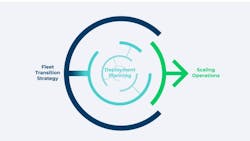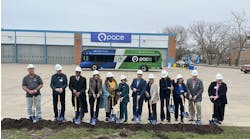OP-ED: Rapidly electrifying fleets: Adaptive planning and a phased approach are key
Fleet electrification is in vogue these days but the roadmap for transitioning an entire fleet is completely unclear. Fleet managers and planners responsible for developing transition plans to zero-emissions buses, vans and trucks are left with many unanswered questions about how to move pilots to scaled deployments by 2030 and fully transition to zero-emissions fleets by 2040.
An adaptive approach to planning—one that considers technology advances and leverages learning curves—can develop confidence for fleet operators to rely on electric drive technology and to cease buying fossil burning trucks and buses sooner than anticipated. It’s time to move beyond fleet electrification pilot deployments by taking a phased and adaptable approach to scaling fleet electrification.
The importance of an adaptable approach
Planning around emergent technology is challenging. It must be underpinned by experience: experience built on trial and error, capability testing and adaptations around known fail points. This takes a plan/trial/iterate process, which can be supported by software-based decision tools. These tools can augment experiential-based learning and inform an adaptable plan.
Put another way, would the expectation be of SpaceX or Virgin Galactic to draw up a perfect plan that achieves reliable and safe cargo delivery at a lower cost while using new technology and the attributes that come with it, all on the first launch? Of course not—that would be a recipe for failure. Fleet electrification should be approached with the same expectations to plan with prudence, adapt with experience and scale the fleet as reliable operations are achieved.
Three phases of planning
It is impossible to stay on track and meet the time frame and costs expected when applying linear planning to an emergent technology. When a plan is broken into phases a narrower set of objectives comes into focus.
In planning for 100-percent fleet electrification, the challenges can seem overwhelming and confidently stating when any milestone will be achieved, challenging. There is a host of decision support software that can fill in the unknowns or even provide planning templates to clarify thresholds that when achieved enable the next phase to begin.
Three primary phases of planning for electric buses has been identified through RMI’s work with public transit agencies, consultancies and software vendors. They aren’t so much sequential as they are layered and cyclical. This construct is not intended to be exact, but rather a guide to serve different constituents that fleet managers report to about their electrification efforts.
1. Fleet transition strategy: An overarching plan that provides a general timeline for stakeholders, allows planners and operators to focus on successful deployments and identifies the critical pathway to a 100-percent zero-emissions fleet.
This transition strategy should address high-level questions and identify what portion of the fleet will be easy, more difficult and the most difficult to electrify. It should answer the following questions:
How does the current procurement cycle change?
When will the fleet be 25 percent, 50 percent, and 100 percent electric or zero emission?
What are the estimated marginal costs for electrification?
What are the funding options?
When will savings be realized?
How much carbon and particulate matter will be reduced?
What is the general geographic deployment sequence and why?
How long to install and commission electric charging infrastructure?
What else must be considered in retooling and skills training?
How often will the Transition Plan be updated?
It should also state the unknowns, which sends a clear message to the next planning phase about what must be answered.
2. Deployment plans: Cyclical but focused plans for each group of procurements and deployments that allows for solving issues, gaining experience and building confidence.
A deployment plan should address specific design needs, costs to inform budgets and schedules for installation. It is intended to test hypotheses about driving range, charging schedules and operational requirements. It should answer the following questions:
Which routes are electric friendly?
What is the test scheme—whether fully electrifying a route or rotational testing across routes?
Which hypotheses are being tested and how will that inform scale?
What is the charging system design and when will installation be complete?
When will vehicles be procured and delivered?
Where will funding come from and what is the contingency plan if grant dependent?
How and when will training take place?
The hypotheses to be tested should be clearly stated to guide data collection and to inform the next deployment plan.
3. Scaling operations: A robust living plan that relies on the results of previous deployments and solely addresses operationalization issues at scale. It should address the following questions:
How can the system’s design be informed by the current characteristics of electric vehicles (and other zero-emissions technologies to follow)?
How will the attributes of electric vehicles be input in work block matching and the related published schedule?
What operational software platforms are needed to aid dispatch?
Which capability thresholds must be met to continue along the scaling timeline?
How will resiliency be built into the system and when does that matter?
Decision support software tools aid the planning process
As previously mentioned, decision support tools help refine each phase of the plan and may even become templates for organizing and communicating plans. Some of these tools are open access for direct use; others are proprietary and used by vehicle manufactures and consultants to build out detailed roadmaps for deploying electric fleets and designing charging depots.
Open Access toolsets:
Microgrid Labs
Electriphi
Atlas Public Policy
California HVIP
AFLEET
Proprietary toolsets:
Init
Proterra Energy
Optibus
EIQ
GIRO
AMPLY Power
The Mobility House
HDR Engineering
JW Associates
Sawatch Labs
Fleet electrification requires an approach in phases, each of which becomes more exact. It also requires getting beyond pilot deployments to demonstration projects quickly. Pilots are for testing technology and demonstrations are for testing operations.
Ultimately, the recommendation is a phased and adaptable approach that takes into account local reality and tests assumptions while uncovering unknowns. First, break down the problem set into known thresholds. Second, consider electrifying entire routes to understand attribute limitations. Third, build up electrifiable routes into an overall garage plan. Fourth, test discrete elements and refine the viability of each route and charging depot. And finally, get comfortable with adaptive planning.
If fleet planners do that, they can be on their way to rapid electrification, advancing the zero-emissions transition and, possibly, comfortable enough to cease buying fossil fueled buses and trucks as a hedge against new drivetrain risks.
-----------------------------
Acknowledgements: This work was made possible by Microgrid Labs in collaboration with Nelson Nygaard and HDR Engineering.



